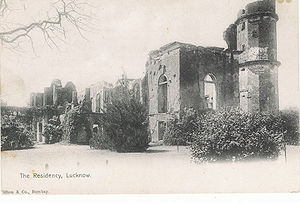Events at Lucknow

This article is part of the events in the Indian Mutiny
Summary
Lucknow was one of the major centres of the Indian Mutiny. Sir Henry Lawrence became Chief Commissioner of the Province of Oudh (Awadh) on March 20th 1857. The garrison at the time consisted of HM 32nd Regiment of Foot, the 7th Native Cavalry, the 13th Regiment of Bengal Native Infantry, the 48th Regiment of Bengal Native Infantry and the 71st Regiment of Bengal Native Infantry, with Indian soldiers outnumbering Europeans 10 to 1. Unrest was evident in the city for several months and when the mutiny reached the province, Lawrence fortified the Residency at Lucknow and took the British inhabitants into the compound. The rebellion broke out on the 30th May and a 87 day siege of the Residency ensued, with Lawrence killed in the first few days.
Forces led by Sir Henry Havelock (see Havelock's Campaign and Sir James Outram reached Lucknow in September (the First Lucknow Relief). After taking the Alambagh, this became the headquarters for subsequent actions at Lucknow. Under heavy assault from the rebels, they were unable to evacuate the Residency as intended and instead bolstered the garrison there, a second siege ensuing for six weeks. The Second Lucknow Relief came in November when Sir Colin Campbell reached Lucknow. On the 16th November, 2000 rebel sepoys besieged at the Secundrabagh villa were massacred when the 93rd Highlanders and the 4th Punjabi Infantry took the estate. Campbell managed to evacuate the besieged Europeans at the Residency, but Havelock died before he was able to leave the city. Outram stayed and defended Lucknow until the following March, when Campbell retook the city. During this action Major Hodson (Commander of Hodson's Horse) was killed and buried in the grounds of La Martiniere College.
Related articles
For details of actions during this period see the following articles
| 1 May 1857 | Mutiny at Lucknow |
| 30 June 1857 | Battle of Chinhut |
| 1 July 1857 | Start of the First Siege of Lucknow |
| 23 September 1857 | Battle of Alambagh |
| 25 September 1857 | First Lucknow Relief |
| 12 November 1857 | Battle of Alambagh |
| 14 November 1857 | Actions at Dilkusha and Martiniere |
| 16 November 1857 | Battle of Secundra Bagh |
| 17 November 1857 | Second Lucknow Relief |
| 27 Nov 1857-10 Mar 1858 | Defence of Alambagh |
| 22 December 1857 | Battle of Gailee by Lucknow |
| 9 March 1858 | Battle of La Martinière |
| 11 March 1858 | Battle of Begum Kothi |
| 14 March 1858 | Battle of Imambara |
| 19 March 1858 | Battle of Moosa Bagh |
| 21 March 1858 | Recapture of Lucknow |
Biographies
Entries in the Dictionary of Indian Biography 1906:
Colin Campbell (1792-1863)
Henry Havelock (1795-1857)
John Inglis (1814-1862)
Henry Lawrence (1806-1857)
Edward Lugard (1810-1898)
Nana Sahib (1820?-1859?)
James Neill (1810-1857)
James Outram (1803-1863)
Tantya Tope (1819-1859)
Interactive Map
<googlemap version="0.9" lat="26.862668" lon="80.946579" type="map" zoom="11" controls="small"> http://maps.google.com/maps/ms?authuser=0&vps=2&ie=UTF8&msa=0&output=nl&msid=211401480495186034184.0004b928142dc45e4caf9 </googlemap>
Siege of Lucknow battle sites
Hover your cursor over the markers on the map to reveal the places marked or use the below index.
Clicking on the markers also produces a balloon with further location details.
Locations index
External Links
Indian Mutiny 1857-58 www.britishempire.co.uk
Siege of Lucknow Wikipedia
Historical books on-line
- List of inscriptions on Christian tombs and tablets of historical interest in the United Provinces of Agra and Oudh by E A H Blunt ICS 1911 Chronology of events and names on monuments of European casualties archive.org
- "The First Bengal European Fusiliers at Lucknow" Blackwood’s Edinburgh Magazine Volume 84, July-December 1858, pages 73-85 Google Books
Recommended Reading
Saul David, Indian Mutiny: 1857 (London: Viking, 2002), ISBN 0670911372 ; (Penguin, 2003), ISBN 0141005548